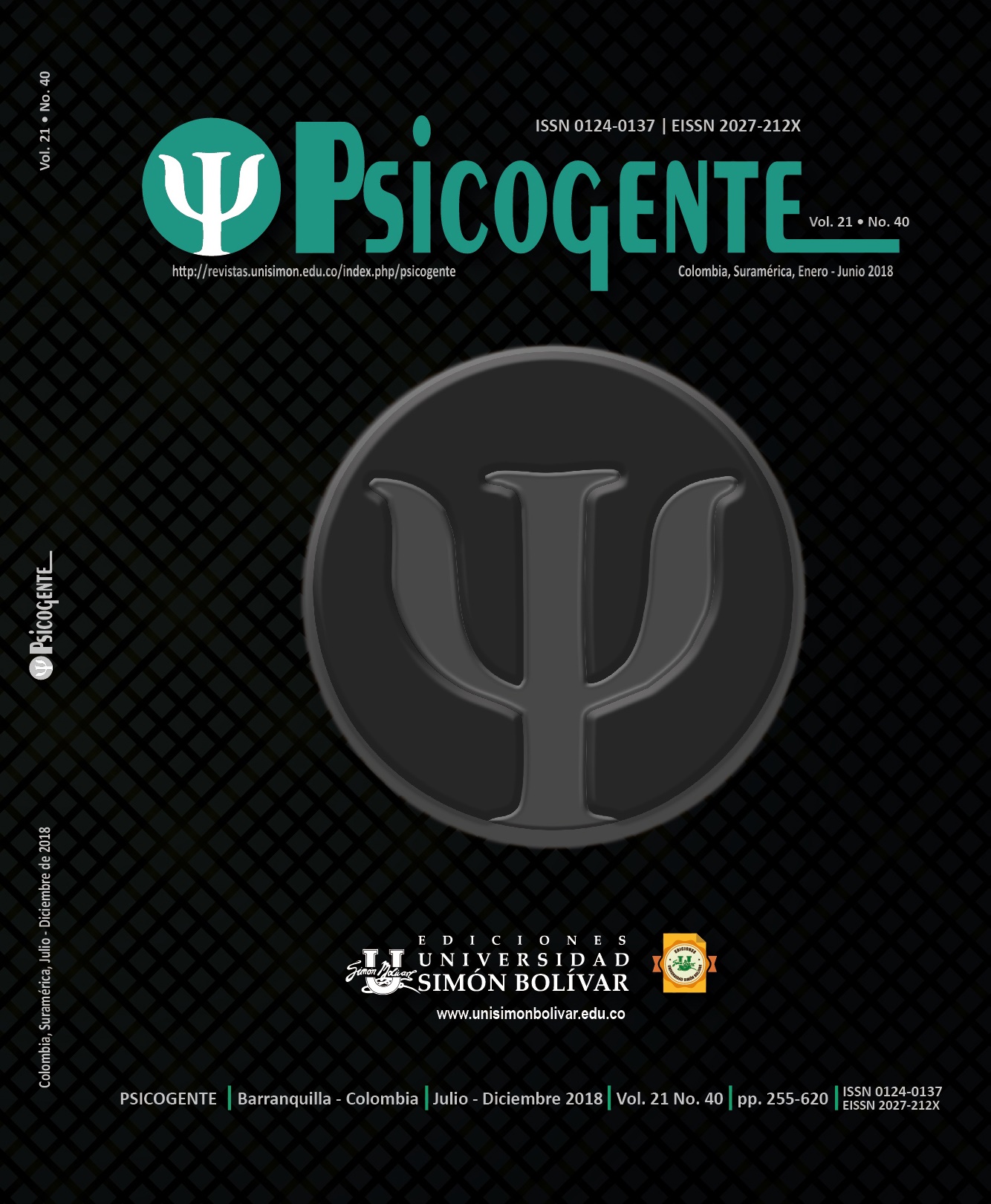Los niños y la comprensión del mundo mental de los otros: Teorías explicativas
Children and their understanding in relation with others’ mental world: Explanatory Theories
DOI:
https://doi.org/10.17081/psico.21.40.3089Palabras clave:
mente, teoría de la mente, estados mentales, desarrollo cognitivo, filosofía de la menteResumen
El objetivo del artículo consistió en revisar, desde el punto de vista teórico, los planteamientos filosóficos y psicológicos que han servido de base para comprender la mente de los Otros por parte de los niños. Se inicia con el concepto de intencionalidad de Brentano (1874-1995), el cual diferencia el mundo físico del mental asumiendo que la mente necesita de objetos para funcionar. Desde la psicología, se abordaron tres teorías: (a) la Teoría de la Simulación o perspectiva de la Primera Persona, propuesta por Gordon (1992), Goldman (1993), Jhonson (1988) y Harris (1995); (b) la Teoría-Teoría o perspectiva de la Tercera Persona, propuesta por Baron-Cohen (2000), Leslie (1987) y Wellman (1995/1990), entre otros, y finalmente, (c) la Teoría de la Intersubjetividad propuesta por Trevarthen (1974, 1979, 1998) como preámbulo a la propuesta de Gómez (1998, 2005) y de Reddy (2008), denominada la perspectiva de la Segunda Persona. Los debates entre estas perspectivas permiten analizar sus diferencias, aportando la posibilidad de enriquecer la mirada acerca de la comprensión de las otras mentes en los niños. En conclusión, se comprende que la teoría de la mente es un concepto que se ha estudiado desde diferentes ópticas, todas las cuales se relacionan a su vez con el concepto de mente.
Descargas
Citas
Astington, J. & Barrault, T. (2001). Children´s theory of mind: How young children come to understand that a people have thoughts and feelings. Infance Young Children, 13(3), 1-12. Disponible en https://journals.lww.com/iycjournal/Citation/2001/13030/Children_s_Theory_of_Mind__How_Young_Children_Come.5.aspx
Astington, J. & Jenkins, J. (1999). A longitudinal study of the relation between language and theory of mind development. Developmental Psychology, 35(5), 1311-1320. Recuperado de http://psycnet.apa.org/doi/10.1037/0012-1649.35.5.1311
Baron-Cohen, S. (2000). Theory of mind and autism: A fifteen years review. En S. Baron-Cohen, H. Tager-Flusberg, & D. Cohen, Understanding other minds: Perspective from development cognitive neuroscience (pp.102-105).Oxford: Oxford University Press.
Benavides, J. (2013). La emergencia de las acciones de tomar del pelo en niños entre los 9 y 48 meses y su relación con el desarrollo de la Teoría de la Mente. Tesis para optar el Título de Doctorado. Cali: Universidad del Valle.
Brentano, F. (1995). Psychology from an empirical point of view. En T. Rancurello., D. Teral. & L. McAllister (Trad.). Londres: Routledge. (Trabajo original publicado en 1874).
Brunsteins, P. (2008). Algunas reflexiones acerca de la simulación mental y la perspectiva de la primera persona. Areté Revista de Filosofía XX (1), 7-38. Disponible en http://revistas.pucp.edu.pe/index.php/arete/article/view/552
Carpendale, J. & Lewis, C. (2006). How children develop social understanding. Oxford, Inglaterra: Blackwell.
Cutting, A. & Dunn, J. (2006). Conversations with siblings and friends: links between relationship quality and social understanding. Developmental Psychology 24(1), 73-87. http://doi.org/10.1348/026151005x70337.
Dunn, J. & Brophy, M. (2005). Communication, relationships, and individual differences in children’s understanding of mind. In J. Astington, & J. Baird (Eds.), Why Language Matters for Theory of Mind (pp. 186-219). Oxford: Oxford Press.
Dunn, J. (1988). The beginnings of Social Understanding. United States of America: Harvard University Press.
Dunn, J., Brown, J., Slomkowski, C., Tesla, C. & Youngblade, L. (1991). Young children’s understanding of other people’s feelings and belief: Individual difference and their antecedents. Child Development, 62(6), 352-1366. DOI: 10.2307/1130811
Goldman, A. I. (1993). The psychology of folk psychology. Behavioral and Brain Sciences, 16(01), 15-28. Disponible en http://users.ecs.soton.ac.uk/harnad/Papers/Py104/goldman.psyc.html
Gómez, J. C. (1998). Do concepts of intersubjeticity apply to non-human primates? En S. Bråten (Ed.). Intersubjective Communication and Emotion in Early Ontogeny (pp.245-259). Cambridge: Cambridge University Press.
Gómez, J. C. (2004/2007). El desarrollo de la mente en los simios, los monos y los niños. Madrid: Morata
Gómez, J. C. (2005). Joint Attention and the Notion of Subject: Insights from Apes, Normal Children, and Children with Autism. En N. Eilan., C. Hoerl., T. McCormack. & J. Roeesler (Ed.) Joint attention: communication and other minds. Issues in Philosophy and Psychology (pp.65-84). Oxford: Oxford University Press.
Gopnik, A. & Wellman, H. (1992). Why the child’s theory of mind really is a theory. Mind and Language, 7(1-2), 145-171. http:/doi/.org/10.1111/j.1468-0017.1992.tb00202.x
Gordon, R. (1986). Folk psychology as simulation. Mind & Language, 1, 158-170. DOI: 10.1111/j.14680017.1986.tb00324.x
Gordon, R. M. (1992). The Simulation Theory: Objections and misconceptions, Mind and Language, 7(1-2), 11-34. DOI: 10.1111/j.1468-0017.1992.tb00195.x
Harris, P. (1992). From simulation to folk psychology: The case for development. Mind and Language, 7(1-2), 120-144. http:/doi/.org/10.1111/j.1468-0017.1992.tb00201.x
Harris, P.L. (1995). The child’s concept of emotion: An introduction. In J. Russell (Ed.) Everyday conceptions of emotions. (pp.283-287). Dordrecht, Holland: Kluwer.
Hughes, C. & Dunn, J. (1998). Understanding mind and emotion longitudinal association with mental-state talk young friends. Developmental Psychology, 34(5), 1026-1037. Disponible en https://www.ncbi.nlm.nih.gov/pubmed/9779748
Johnson, C. (1988). Theory of mind and the structure of conscious experience. En J. Astington, P. Harris, & D. Olson (Eds.), Developing theories of mind (pp.47-63). Oxford, Inglaterra: Cambridge University Press.
Leslie, A. (1987). Pretense and representation: The origin of the theroy of mind. Psychological Review, 94(7), 412-426. Disponible en http://psycnet.apa.org/buy/1988-13495-001
Martínez, M. (2011). Intersubjetividad y teoría de la mente. Psicología del Desarrollo, 1(11), 9-28. Disponible en http://apadea.org.ar/fotos/2012/11/Mart%C3%83%-C2%ADnez-M.-2011-Intersubjetividad-y-Teor%C3%83%C2%ADa-de-la-Mente-1.pdf
Martínez-Freire, P. (1995). La nueva filosofía de la mente. Barcelona: Gedisa. Naito, M. (2003). The relation between theory of mind and episodic memory: Evidence for the development of autonoetic conscience. Journal of Experimental Psychology, 85, 312-336. https://doi.org/10.1016/S0022-0965(03)00075-4
Naito, M. (2016). The socio-cultural construction of theory of mind: A critical evaluation of cognitive science from phenomenological perspective. Japanese Journal of Developmental Psychology, 27(4), 288-298. Disponible en http://www2.fiit.stuba.sk/~kvasnicka/CognitiveScience/Friedenberg_Cognitive%20science.pdf
Naito, M. & Koyama, K. (2006).The development of false beliefe understanding in japanese children. Delay and deviance? International Journal of Behavior Development, 30(4), 290-304. http://dx.doi.org/10.1177%2F0165025406063622
Perner, J. (1994). Comprender la mente representacional. En M.A. Galmarini (Trad). Madrid: Paidós (Trabajo original publicado en 1991)
Raver, C. & Leadbeater, B. (1993). The problem of the other research theory of mind and social development. Human Development, 36, 350-367. DOI: 10.1159/000278223
Reddy, V. (2008). How infants know minds. Cambridge: Harvard University Press.
Reedy, V. (2001). Infants clowns: The interpersonal creation of humor in infancy. Enfance, 52(3), 247-256. DOI: 10.3917/enf.533.0247
Rivière, Á. (2000). Teoría de la mente y metarrepresentación. En M. Rodríguez. & P. Chacón, Pensando la mente: Perspectivas en filosofía y psicología (pp.271-324). Madrid: Biblioteca Nueva Editorial.
Riviére, A. & Núñez, M. (1996). La mirada mental. Buenos Aires: Aique. Slade, L. & Ruffman, T. (2005). How language does (and does not) relate to theory of mind: A longitudinal study of sintaxis, semantics, working memory and false belief. British journal of Developmental Psychology, 23, 117-141. DOI: http://dx.doi.org/10.1348/026151004X21332.
Stich, S. & Nichols, S. (1992). Folk Psychology: Simulation a tacit theory. Mind and Language, 7(1), 35-71. DOI: 10.1111/j.1468-0017.1992.tb00196.x
Stich, S. & Nichols, S. (2003). Folk Psychology. En S. Stich, & T. Warfields. The blackwell guide of philosophy of mind (pp.235-255). Oxford: Blackwell.
Tomasello, M. (1999). The Cultural Origins of Human Cognition. United States of America: Harvard University Press.
Trevarthen, C. (1974). Conversations with a two-month-old. New Scientist. 2, 230-235
Trevarthen, C. (1976). Descriptive analyses of infant communicative behaviour. En I. H. Schaf--fer, Studies in mother-infant interaction. Londres: Academic Press.
Trevarthen, C. (1979). Instincts for human understanding and for cultural cooperation: Their development in infancy. En M. von Cranach, K. Foppa, W. Lepenies, & D. Ploog, Human ethology: Claims and limitsof new discipline. Cambridge: Cambridge Unirvesity Press.
Trevarthen, C. (1998). The concept and foundations of infant intersubjectivity. En Braten, S. (Ed) Intersubjective communication and emotion in early ontogeny (pp. 15-46). Cambridge: Cambridge University Press.
Wellman, H. (1995). Desarrollo de la teoria del pensamiento en los niños. En C. Boulandier (Trad).Madrid: Desclée De Brouwer. (Trabajo original publicado en 1990).
Wellman, H. & Liu, D. (2004). Scaling of theory of mind task. Child Development, 75(2), 523-541. DOI: 10.1111/j.1467-8624.2004.00691.x
Wellman, H. & Woolley, J. (1990). From simple desires to ordinary belief: the early development of everyday psychology. Cognition, 35, 245-275. Disponible en https://www.ncbi.nlm.nih.gov/pubmed/2364653
Wellman, H., Cross, D. & Watson, J. (2001). Meta-analysis of theory of mind development: The truth about false belief. Child Development, 72, 655-684. DOI: 10.1111/1467-8624.00304
Wimmer, H. & Perner, J. (1983). Belief about beliefs: Representation and constrain function of wrong belief in young children`s understanding of deception. Cognition, 13, 103-128. https://doi.org/10.1016/0010-0277(83)90004-5
Publicado
Cómo citar
Número
Sección
Licencia
Derechos de autor 2018 Jacqueline Benavides Delgado

Esta obra está bajo una licencia internacional Creative Commons Atribución 4.0.
Desde la revista Psicogente impartimos una política de respeto con nuestra comunidad científica incluyendo a nuestros autores. Los autores tienen derecho a un trato respetuoso y atento en el proceso Editorial, que las evaluaciones de sus artículos sean justas, imparciales (para ello la revista procederá con la evaluación doble ciego) y se realicen en un tiempo razonable. Se deberá mantener la confidencialidad y los permisos para proceder con la publicación. Todo cambio solicitado por parte del comité, los pares y el Editor deberán ser explícitos y claramente justificados. Especifica que los autores/as conservarán sus derechos de autor y garantizarán a la revista el derecho de primera publicación de su obra, el cual estará simultáneamente sujeto a la Licencia de reconocimiento de Creative Commons BY que permite a terceros compartir la obra siempre que se indique su autor y su primera publicación a esta revista.
Garantizamos un proceso editorial transparente: desde las acciones de recepción del articulo hasta la validación final del mismo, se hará en comunicación constante con el autor. Las modificaciones en el estado de los artículos, así como las diversas decisiones tomadas sobre él y los tiempos de ejecución empleados se realizarán haciendo uso de la plataforma OJS y de ser necesario en contacto directo a través del correo de autores y de la revista Psicogente. Así mismo se procura la escogencia de Pares revisores idóneos: con perfiles y experiencia que lleven a una avaluación de calidad de cada documento sometido a revisión.






